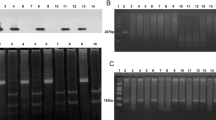Summary
High molecular weight DNA of up to 20 kbp and, additionally, an RNase-insensitive RNA of more than 60 b were isolated from plasmapheresis fluids taken from patients with active systemic lupus erythematosus (SLE). Similar nucleic acids could not be demonstrated in the plasma samples from patients with Waldenstroem's disease, rheumatoid arthritis, myasthenia gravis, and other diseases including active systemic disorders. The purified nucleic acids were analyzed in several ways; they proved to be immunogenic by inducing polyclonal and monoclonal antibodies to natural DNA as well as to synthetic polynucleotides (e.g. polyguanylic acid) after injection into experimental animals (rabbits or mice respectively). Biochemical and molecular cloning analysis of the DNA revealed features like high levels of CpG-dinucleotides, usually not observed in common human DNA. A possible exogenous origin was substantiated by comparative sequence studies of cloned plasma DNA, which showed homologies to human retroviruses, e.g. PL1 (85%/60 b) and the sequences of the gag and pol genes of human immunodeficiency virus type I (85%/157 b). Experiments applying isolated plasma nucleic acids in transfection experiments showed the induction of morphological changes in an EBV-immortalized B-cell line drawn from a healthy human donor, such as vacuolization and syncitia formation. Northern blot analysis demonstrated, exclusively in the transfected cell line, the expression of mRNA homologous to the cloned plasma DNA. Using this clone as a probe, homologous sequences could be demonstrated by Northern blot analysis in EBV-immortalized cell lines from SLE patients only and, by means of DNA amplification, in peripheral blood lymphocytes from SLE and AIDS patients. A cDNA library has been established, and sequencing is under way to gain more specific primers and probes for different chronic inflammatory diseases.
Similar content being viewed by others
References
Query CC, Keene JD (1987) A human autoimmune protein associated with U1 RNA contains a region of homology that is crossreactive with retroviral p30 gag antigen. Cell 51:211
Eshenbugh DL, Seno D, James F (1974) Rapid sedimentation of E. coli in the presence of polyethylene glycol at lg. Anal Biochem 58:390
Zubler RH, Perrin LH, Creighton WD, Lambert PH (1977) Use of polyethylene glycol (PEG) to concentrate immune complexes from serum or plasma samples. Ann Rheum Dis 36:23
Krapf F, Herrmann M, Leitmann W, Kalden JR (1989) Antibody binding of macromolecular DNA and RNA in the plasma of SLE patients. Clin Exp Immunol 75:336–342
Deininger PL, Jolly DJ, Rubin CM, Friedmann T, Schmidt CW (1981) Base sequence studies of 300 nucleotide renatured repeated human DNA clones. J Mol Biol 151:17
Kuo KC, McCune RA, Gehrke ChW, Midgett R, Ehrlich M (1980) Quantitative reversed-phase high performance liquid chromatographic determination of major and modified deoxyribonucleosides in DNA. Nucleic Acids Res 8:4763
Sanger F, Nicklen S, Coulson R (1977) DNA sequencing with chain terminating inhibitors. Proc Natl Acad Sci USA 74:5463
Queen C, Korn LJ (1984) A comprehensive sequence analysis program for the IBM personal computer. Nucleic Acids Res 12:581
Li JK, Parker B, Kowalik T (1987) Rapid alkaline blottransfer of viral dsRNAs. Anal Biochem 163:210
Hirt B (1967) Selective extraction of polyoma DNA from infected mouse cell cultures. J Mol Biol 26:365
Stollar BD (1986) Anti-DNA antibodies. Crit Rev Biochem 20:1
Herrmann M, Leitmann W, Krapf EF, Kalden JR (1988) Molecular characteristics and in vitro effects of nucleic acids from plasma of patients with systemic lupus erythematosus. J Cell Biochem Suppl: Molecular and cellular mechanisms of human hypersensitivity and autoimmunity, pp 1–2
Steinman CR, Ackad A (1977) Appearance of circulating DNA during hemodialysis. Am J Med 62:693
Chitrabamrung S, Rubin RL, Tan EM (1981) Serum deoxyribonuclease I and clinical activity in systemic lupus erythematosus. Rheumatol Int 1:55–60
Okamoto T, Tamura T, Takano T (1983) Evidence in patients with systemic lupus erythematosus of the presence of antibodies against RNA-dependent DNA polymerase of baboon endogenous virus. Clin Exp Immunol 54:747
Shirai T, Ohta K, Kohno A, Furukawa F, Yoshida H, Maruyama K, Hirose S (1986) Naturally occurring antibody response to DNA is associated with the response to retroviral gp70 in autoimmune New Zealand mice. Arthritis Rheum 29:242
Olsen RG, Tarr MJ, Mathes LE, Whisler R, DuPlessis D, Schulz EJ, Blakeslee JR (1987) Serological and virological evidence of human T-lymphotropic virus in systemic lupus erythematosus. Med Microbiol Immunol 176:53
Rucheton M, Graafland H, Fanton H, Ursule I, Ferrier P, Larsen CJ (1985) Presence of circulating antibodies against gag gene MULV proteins in patients with autoimmune connective tissue disorders. Virology 144:468
Ehrlich HH, Gelfand DH, Saiki RK (1988) Specific DNA amplification. Nature 331:461
Guy B, Kieny MP, Riviere Y, Le Peuch C, Dott K, Girards M, Montagnier L, Lecocq J-P (1987) HIV F/3′ orf encodes a phosphorylated GTP-binding protein resembling an oncogene product. Nature 330:226
Author information
Authors and Affiliations
Rights and permissions
About this article
Cite this article
Krapf, F.E., Herrmann, M., Leitmann, W. et al. Are retroviruses involved in the pathogenesis of SLE?. Rheumatol Int 9, 115–121 (1989). https://doi.org/10.1007/BF00271867
Issue Date:
DOI: https://doi.org/10.1007/BF00271867




